Cybersecurity Testing for Automotive Domain: A Survey
Abstract
:1. Introduction
2. Methodology
2.1. Research Questions
- RQ1. What are cybersecurity testing methods applied in the automotive domain?
- RQ2. What testbeds are used for automotive cybersecurity testing?
- RQ3. What are the research challenges in this topic area?
2.2. Search Process
2.2.1. Search Database
2.2.2. Search String
2.2.3. Search Procedure
2.3. Search Criterion
2.4. Search Results
3. Automotive Cybersecurity Testing Methods
3.1. Knowledge-Based Testing
3.2. Automation-Based Testing
3.3. Threat-Based Testing
3.3.1. Vulnerability Scanning
3.3.2. Penetration Testing
3.3.3. Fuzzing
3.3.4. Risk-Based Security Testing
3.4. Requirements-Based Testing
Functional Security Testing
3.5. Model-Based Testing
4. Automotive Cybersecurity Testing Testbeds
5. Discussion
6. Conclusions
Author Contributions
Funding
Institutional Review Board Statement
Informed Consent Statement
Data Availability Statement
Conflicts of Interest
References
- Upstream. Upstream Security Global Automotive Cybersecurity Report 2022; Upstream Security Ltd.: Herzliya, Israel, 2022. [Google Scholar]
- Miller, C.; Valasek, C. Remote exploitation of an unaltered passenger vehicle. In Proceedings of the Black Hat USA 2015, Las Vegas, NV, USA, 1–6 August 2015; p. 91. [Google Scholar]
- Thing, V.L.L.; Wu, J. Autonomous Vehicle Security: A Taxonomy of Attacks and Defences. In Proceedings of the 2016 IEEE International Conference on Internet of Things (iThings) and IEEE Green Computing and Communications (GreenCom) and IEEE Cyber, Physical and Social Computing (CPSCom) and IEEE Smart Data (SmartData), Chengdu, China, 15–18 December 2016; pp. 164–170. [Google Scholar] [CrossRef]
- Yu, J.; Wagner, S.; Wang, B.; Luo, F. A Systematic Mapping Study on Security Countermeasures of In-Vehicle Communication Systems. SAE Int. J. Transp. Cybersecur. Priv. 2021, 4, 97–116. [Google Scholar] [CrossRef]
- Zhang, Y.; Han, S.; Zhong, S.; Shi, P.; Shao, X. Research on Information Security Test Evaluation Method Based on Intelligent Connected Vehicle. In Security and Privacy in New Computing Environments, Proceedings of the International Conference on Security and Privacy in New Computing Environments, Tianjin, China, 13–14 April 2019; Springer: Cham, Switzerland, 2019; pp. 178–197. [Google Scholar]
- SAE J3061; Cybersecurity Guidebook for Cyber-Physical Vehicle Systems. SAE International: Warrendale, PA, USA, 2016.
- ISO/SAE 21434:2021; Road Vehicles—Cybersecurity Engineering. ISO/TC 22/SC 32 Electrical and Electronic Components and General System Aspects. ISO: Geneva, Switzerland, 2021.
- WP.29 R155; UN Regulation No. 155-Cyber Security and Cyber Security Management System. The United Nations Economic Commission for Europe (UNECE): Geneva, Switzerland, 2021.
- Wooderson, P.; Ward, D. Cybersecurity Testing and Validation. In Proceedings of the WCX 17: SAE World Congress Experience, Detroit, MI, USA, 4–6 April 2017. [Google Scholar] [CrossRef]
- Pekaric, I.; Sauerwein, C.; Felderer, M. Applying Security Testing Techniques to Automotive Engineering. In Proceedings of the 14th International Conference on Availability, Reliability and Security, Canterbury, UK, 26–29 August 2019; p. 10. [Google Scholar] [CrossRef]
- Mahmood, S.; Nguyen, H.N.; Shaikh, S.A. Automotive Cybersecurity Testing: Survey of Testbeds and Methods. In Digital Transformation, Cyber Security and Resilience of Modern Societies; Tagarev, T., Atanassov, K.T., Kharchenko, V., Kacprzyk, J., Eds.; Springer International Publishing: Cham, Switzerland, 2021; pp. 219–243. [Google Scholar]
- Bayer, S.; Enderle, T.; Oka, D.-K.; Wolf, M. Automotive Security Testing—The Digital Crash Test. In Energy Consumption and Autonomous Driving, Proceedings of the 3rd CESA Automotive Electronics Congress, Paris, France, 3–4 December 2014; Springer: Cham, Switzerland, 2016; pp. 13–22. [Google Scholar]
- Ebert, C.; Rekik, Y.; Karade, R. Security Test. IEEE Softw. 2020, 37, 13–20. [Google Scholar] [CrossRef]
- Wohlin, C. Guidelines for snowballing in systematic literature studies and a replication in software engineering. In Proceedings of the 18th International Conference on Evaluation and Assessment in Software Engineering, London, UK, 13–14 May 2014; pp. 1–10. [Google Scholar] [CrossRef]
- Imparato, A.; Maietta, R.R.; Scala, S.; Vacca, V. A Comparative Study of Static Analysis Tools for AUTOSAR Automotive Software Components Development. In Proceedings of the IEEE International Symposium on Software Reliability Engineering Workshops (ISSREW), Toulouse, France, 23–26 October 2017; pp. 65–68. [Google Scholar] [CrossRef]
- Ebert, C.; Ray, R. Penetration Testing for Automotive Cybersecurity. ATZelectronics Worldw. 2021, 16, 16–22. [Google Scholar] [CrossRef]
- Marksteiner, S.; Ma, Z. Approaching the Automation of Cyber Security Testing of Connected Vehicles. In Proceedings of the Third Central European Cybersecurity Conference, Munich, Germany, 14 November 2019; pp. 1–3. [Google Scholar] [CrossRef] [Green Version]
- Marksteiner, S.; Marko, N.; Smulders, A.; Karagiannis, S.; Stahl, F.; Hamazaryan, H.; Schlick, R.; Kraxberger, S.; Vasenev, A. A Process to Facilitate Automated Automotive Cybersecurity Testing. In Proceedings of the IEEE 93rd Vehicular Technology Conference (VTC2021-Spring), Helsinki, Finland, 25–28 April 2021; pp. 1–7. [Google Scholar] [CrossRef]
- MISRA C:2012; Guidelines for the Use of the C Language Critical Systems. MIRA Ltd.: Nuneaton, UK, 2013.
- Altinger, H.; Wotawa, F.; Schurius, M. Testing methods used in the automotive industry: Results from a survey. In Proceedings of the Workshop on Joining AcadeMiA and Industry Contributions to Test Automation and Model-Based Testing (JAMAICA 2014), San Jose, CA, USA, 21 July 2014; pp. 1–6. [Google Scholar] [CrossRef]
- Montisci, D. Security-Oriented Dynamic Code Analysis in Automotive Embedded Systems. Master’s Thesis, Politecnico di Torino, Torino, Italy, 2018. [Google Scholar]
- Josephlal, E.F.M.; Adepu, S. Vulnerability Analysis of an Automotive Infotainment System’s WIFI Capability. In Proceedings of the IEEE 19th International Symposium on High Assurance Systems Engineering (HASE), Hangzhou, China, 3–5 January 2019; pp. 241–246. [Google Scholar] [CrossRef]
- ISO 14229; Road Vehicles—Unified Diagnostic Services (UDS). ISO/TC 22/SC 31 Data Communication. ISO: Geneva, Switzerland, 2013.
- Luo, F.; Zhang, X.; Hou, S. Research on Cybersecurity Testing for In-vehicle Network. In Proceedings of the International Conference on Intelligent Technology and Embedded Systems (ICITES), Chengdu, China, 31 October–2 November 2021; pp. 144–150. [Google Scholar] [CrossRef]
- Weiss, N.; Renner, S.; Mottok, J.; Matoušek, V. Transport Layer Scanning for Attack Surface Detection in Vehicular Networks. In Proceedings of the Computer Science in Cars Symposium (CSCS 20), Feldkirchen, Germany, 4 December 2020; pp. 1–8. [Google Scholar]
- Koscher, K.; Czeskis, A.; Roesner, F.; Patel, S.; Kohno, T.; Checkoway, S.; McCoy, D.; Kantor, B.; Anderson, D.; Shacham, H.; et al. Experimental Security Analysis of a Modern Automobile. In Proceedings of the IEEE Symposium on Security and Privacy, Oakland, CA, USA, 16–19 May 2010; pp. 447–462. [Google Scholar] [CrossRef] [Green Version]
- Mazloom, S.; Rezaeirad, M.; Hunter, A.; McCoy, D. A Security Analysis of an In-Vehicle Infotainment and App Platform. In Proceedings of the 10th USENIX Workshop on Offensive Technologies (WOOT 16), Austin, TX, USA, 8–9 August 2016. [Google Scholar]
- Yan, C.; Xu, W.; Liu, J. Can you trust autonomous vehicles: Contactless attacks against sensors of self-driving vehicle. In Proceedings of the Def Con Hacking Conference, Las Vegas, NV, USA, 4 August 2016; p. 109. [Google Scholar]
- Shin, H.; Kim, D.; Kwon, Y.; Kim, Y. Illusion and Dazzle: Adversarial Optical Channel Exploits against Lidars for Automotive Applications. In CHES 2017: Cryptographic Hardware and Embedded Systems—CHES 2017, Proceedings of the International Conference on Cryptographic Hardware and Embedded Systems, Taipei, Taiwan, 25–28 September 2017; Springer: Cham, Switzerland, 2017; pp. 445–467. [Google Scholar]
- Miller, C.; Valasek, C. Adventures in automotive networks and control units. In Proceedings of the Def Con Hacking Conference, Las Vegas, NV, USA, 1–4 August 2013; pp. 15–31. [Google Scholar]
- Shoukry, Y.; Martin, P.; Tabuada, P.; Srivastava, M. Non-invasive Spoofing Attacks for Anti-lock Braking Systems. In Cryptographic Hardware and Embedded Systems—CHES 2013, Proceedings of the International Conference on Cryptographic Hardware and Embedded Systems, Santa Barbara, CA, USA, 20–23 August 2013; Springer: Berlin/Heidelberg, Germany, 2013; pp. 55–72. [Google Scholar]
- Woo, S.; Jo, H.J.; Lee, D.H. A Practical Wireless Attack on the Connected Car and Security Protocol for In-Vehicle CAN. IEEE Trans. Intell. Transp. Syst. 2015, 16, 993–1006. [Google Scholar] [CrossRef]
- Petit, J.; Stottelaar, B.; Feiri, M.; Kargl, F. Remote attacks on automated vehicles sensors: Experiments on camera and lidar. In Proceedings of the Black Hat Europe, Amsterdam, The Netherlands, 10–13 November 2015; p. 995. [Google Scholar]
- Abbott-McCune, S.; Shay, L.A. Techniques in hacking and simulating a modem automotive controller area network. In Proceedings of the IEEE International Carnahan Conference on Security Technology (ICCST), Orlando, FL, USA, 24–27 October 2016; pp. 1–7. [Google Scholar] [CrossRef]
- Nie, S.; Liu, L.; Du, Y. Free-fall: Hacking tesla from wireless to can bus. In Proceedings of the Black Hat USA, Las Vegas, NV, USA, 22–25 July 2017; pp. 1–16. [Google Scholar]
- Cheah, M.; Shaikh, S.A.; Haas, O.; Ruddle, A. Towards a systematic security evaluation of the automotive Bluetooth interface. Veh. Commun. 2017, 9, 8–18. [Google Scholar] [CrossRef]
- Milburn, A.; Timmers, N.; Wiersma, N.; Pareja, R.; Cordoba, S. There will be glitches: Extracting and analyzing automotive firmware efficiently. In Proceedings of the Black Hat USA, Las Vegas, NV, USA, 8–9 August 2018. [Google Scholar]
- Jeong, H.; So, J. Channel correlation-based relay attack avoidance in vehicle keyless-entry systems. Electron. Lett. 2018, 54, 395–397. [Google Scholar] [CrossRef]
- Dürrwang, J.; Braun, J.; Rumez, M.; Kriesten, R.; Pretschner, A. Enhancement of Automotive Penetration Testing with Threat Analyses Results. SAE Int. J. Transp. Cybersecur. Priv. 2018, 1, 91–112. [Google Scholar] [CrossRef]
- Sommer, F.; Durrwang, J.; Wolf, M.; Juraschek, H.; Ranert, R.; Kriesten, R. Automotive network protocol detection for supporting penetration testing. In Proceedings of the SECURWARE 2019, Nice, France, 27–31 October 2019; pp. 114–119. [Google Scholar]
- He, K.; Qin, K.; Wang, C.; Fang, X. Research on Cyber Security Test Method for GNSS of Intelligent Connected Vehicle. In Proceedings of the International Conference on Computer Information and Big Data Applications (CIBDA), Guiyang, China, 17–19 April 2020; pp. 200–203. [Google Scholar] [CrossRef]
- Zachos, M.; Subke, P. Test Method for the SAE J3138 Automotive Cyber Security Standard. In Proceedings of the WCX SAE World Congress, Detroit, MI, USA, 21–23 April 2020. [Google Scholar] [CrossRef]
- Kexun, H.; Changyuan, W.; Yanyan, H.; Xiyu, F. Research on cyber security Technology and Test Method of OTA for Intelligent Connected Vehicle. In Proceedings of the International Conference on Big Data, Artificial Intelligence and Internet of Things Engineering (ICBAIE), Fuzhou, China, 12–14 June 2020; pp. 194–198. [Google Scholar] [CrossRef]
- Wen, H.; Chen, Q.A.; Lin, Z. {Plug-N-Pwned}: Comprehensive Vulnerability Analysis of {OBD-II} Dongles as A New {Over-the-Air} Attack Surface in Automotive {IoT}. In Proceedings of the 29th USENIX Security Symposium (USENIX Security 20), Boston, MA, USA, 12–14 August 2020; pp. 949–965. [Google Scholar]
- Lee, H.; Choi, K.; Chung, K.; Kim, J.; Yim, K. Fuzzing CAN Packets into Automobiles. In Proceedings of the IEEE 29th International Conference on Advanced Information Networking and Applications, Gwangju, Korea, 24–27 March 2015; pp. 817–821. [Google Scholar] [CrossRef]
- Fowler, D.S.; Bryans, J.; Shaikh, S.A.; Wooderson, P. Fuzz Testing for Automotive Cyber-Security. In Proceedings of the 48th Annual IEEE/IFIP International Conference on Dependable Systems and Networks Workshops (DSN-W), Luxembourg, 25–28 June 2018; pp. 239–246. [Google Scholar] [CrossRef]
- Fowler, D.S.; Bryans, J.; Cheah, M.; Wooderson, P.; Shaikh, S.A. A Method for Constructing Automotive Cybersecurity Tests, a CAN Fuzz Testing Example. In Proceedings of the IEEE 19th International Conference on Software Quality, Reliability and Security Companion (QRS-C), Sofia, Bulgaria, 22–26 July 2019; pp. 1–8. [Google Scholar] [CrossRef]
- Werquin, T.; Hubrechtsen, M.; Thangarajan, A.; Piessens, F.; Mühlberg, J.T. Automated Fuzzing of Automotive Control Units. In Proceedings of the International Workshop on Secure Internet of Things (SIOT), Luxembourg, 26–26 September 2019; pp. 1–8. [Google Scholar] [CrossRef]
- Radu, A.-I.; Garcia, F.D. Grey-box analysis and fuzzing of automotive electronic components via control-flow graph extraction. In Proceedings of the Computer Science in Cars Symposium, Feldkirchen, Germany, 2 December 2020; pp. 1–11. [Google Scholar] [CrossRef]
- Zhang, H.; Huang, K.; Wang, J.; Liu, Z. CAN-FT: A Fuzz Testing Method for Automotive Controller Area Network Bus. In Proceedings of the International Conference on Computer Information Science and Artificial Intelligence (CISAI), Kunming, China, 17–19 September 2021; pp. 225–231. [Google Scholar] [CrossRef]
- Nishimura, R.; Kurachi, R.; Ito, K.; Miyasaka, T.; Yamamoto, M.; Mishima, M. Implementation of the CAN-FD protocol in the fuzzing tool beSTORM. In Proceedings of the IEEE International Conference on Vehicular Electronics and Safety (ICVES), Beijing, China, 10–12 July 2016; pp. 1–6. [Google Scholar] [CrossRef]
- Li, Y.; Chen, H.; Zhang, C.; Xiong, S.; Liu, C.; Wang, Y. Ori: A Greybox Fuzzer for SOME/IP Protocols in Automotive Ethernet. In Proceedings of the 27th Asia-Pacific Software Engineering Conference (APSEC), Singapore, 1–4 December 2020; pp. 495–499. [Google Scholar] [CrossRef]
- Bayer, S.; Enderle, T.; Oka, D.K.; Wolf, M. Security crash test—Practical security evaluations of automotive onboard IT components. In Proceedings of the 6th Automotive “Safety and Security 2014”, Stuttgart, Germany, 20–22 August 2014; pp. 125–140. [Google Scholar]
- Patki, P.; Gotkhindikar, A.; Mane, S. Intelligent Fuzz Testing Framework for Finding Hidden Vulnerabilities in Automotive Environment. In Proceedings of the Fourth International Conference on Computing Communication Control and Automation (ICCUBEA), Pune, India, 16–18 August 2018; pp. 1–4. [Google Scholar] [CrossRef]
- Moukahal, L.J.; Zulkernine, M.; Soukup, M. Vulnerability-Oriented Fuzz Testing for Connected Autonomous Vehicle Systems. IEEE Trans. Reliab. 2021, 70, 1422–1437. [Google Scholar] [CrossRef]
- Moukahal, L.J.; Zulkernine, M.; Soukup, M. Boosting Grey-box Fuzzing for Connected Autonomous Vehicle Systems. In Proceedings of the IEEE 21st International Conference on Software Quality, Reliability and Security Companion (QRS-C), Hainan, China, 6–10 December 2021; pp. 516–527. [Google Scholar] [CrossRef]
- Vinzenz, N.; Oka, D.K. Integrating Fuzz Testing into the Cybersecurity Validation Strategy. In Proceedings of the SAE WCX Digital Summit, Virtual, 12–15 April 2021. [Google Scholar] [CrossRef]
- Oka, D.K.; Fujikura, T.; Kurachi, R. Shift left: Fuzzing earlier in the automotive software development lifecycle using hil systems. In Proceedings of the 16th ESCAR Europe, Brussels, Belgium, 15–16 November 2018; pp. 1–13. [Google Scholar]
- E-safety Vehicle Intrusion Protected Applications (EVITA). Available online: http://www.evitaproject.org/ (accessed on 10 November 2022).
- HEAling Vulnerabilities to ENhance Software Security and Safety (HEAVENS) Project. Available online: https://research.chalmers.se/en/project/5809 (accessed on 13 November 2022).
- Schmittner, C.; Ma, Z.; Smith, P. FMVEA for Safety and Security Analysis of Intelligent and Cooperative Vehicles. In Computer Safety, Reliability, and Security, Proceedings of the International Conference on Computer Safety, Reliability, and Security, Florence, Italy, 8–9 September 2014; Springer: Cham, Switzerland, 2014; pp. 282–288. [Google Scholar]
- Macher, G.; Sporer, H.; Berlach, R.; Armengaud, E.; Kreiner, C. SAHARA: A security-aware hazard and risk analysis method. In Proceedings of the Design, Automation & Test in Europe Conference & Exhibition (DATE), Grenoble, France, 9–13 March 2015; pp. 621–624. [Google Scholar] [CrossRef]
- Monteuuis, J.-P.; Boudguiga, A.; Zhang, J.; Labiod, H.; Servel, A.; Urien, P. SARA: Security Automotive Risk Analysis Method. In Proceedings of the 4th ACM Workshop on Cyber-Physical System Security (CPSS ’18), New York, NY, USA, 4 June 2018; pp. 3–14. [Google Scholar] [CrossRef]
- Schmittner, C.; Ma, Z.; Schoitsch, E.; Gruber, T. A Case Study of FMVEA and CHASSIS as Safety and Security Co-Analysis Method for Automotive Cyber-physical Systems. In Proceedings of the 1st ACM Workshop on Cyber-Physical System Security (CPSS ’15), New York, NY, USA, 14 March–14 April 2015; pp. 69–80. [Google Scholar] [CrossRef]
- Intelligent Transport Systems (ITS); Security; Threat, Vulnerability and Risk Analysis (TVRA): Nice, France, 2010.
- Schmidt, K.; Kroll, H.-M.; Tröger, P.; Bünger, T.; Neuhaus, C.; Krueger, F. Adapted Development Process for Security in Networked Automotive Systems. SAE Int. J. Passeng. Cars—Electron. Electr. Syst. 2014, 7, 516–526. [Google Scholar] [CrossRef]
- Dürrwang, J.; Beckers, K.; Kriesten, R. A Lightweight Threat Analysis Approach Intertwining Safety and Security for the Automotive Domain. In Computer Safety, Reliability, and Security, Proceedings of the International Conference on Computer Safety, Reliability, and Security, Trento, Italy, 13–15 September 2017; Springer: Cham, Switzerland, 2017; pp. 305–319. [Google Scholar]
- Bella, G.; Biondi, P.; Costantino, G.; Matteucci, I. CINNAMON: A Module for AUTOSAR Secure Onboard Communication. In Proceedings of the 16th European Dependable Computing Conference (EDCC), Munich, Germany, 7–10 September 2020; pp. 103–110. [Google Scholar] [CrossRef]
- Khan, J. Vehicle network security testing. In Proceedings of the Third International Conference on Sensing, Signal Processing and Security (ICSSS), Chennai, India, 4–5 May 2017; pp. 119–123. [Google Scholar] [CrossRef]
- AUTOSAR. Requirements on Secure Onboard Communication AUTOSAR CP Release 4.3.1; AUTOSAR Release Management: Munich, Germany, 2017. [Google Scholar]
- Cheah, M.; Nguyen, H.N.; Bryans, J.; Shaikh, S.A. Formalising Systematic Security Evaluations Using Attack Trees for Automotive Applications. In Information Security Theory and Practice, Proceedings of the IFIP International Conference on Information Security Theory and Practice, Heraklion, Greece, 28–29 September 2017; Springer: Cham, Switzerland, 2018; pp. 113–129. [Google Scholar]
- Heneghan, J.; Shaikh, S.A.; Bryans, J.; Cheah, M.; Wooderson, P. Enabling Security Checking of Automotive ECUs with Formal CSP Models. In Proceedings of the 49th Annual IEEE/IFIP International Conference on Dependable Systems and Networks Workshops (DSN-W), Portland, OR, USA, 24–27 June 2019; pp. 90–97. [Google Scholar] [CrossRef]
- Mahmood, S.; Fouillade, A.; Nguyen, H.N.; Shaikh, S.A. A Model-Based Security Testing Approach for Automotive Over-The-Air Updates. In Proceedings of the IEEE International Conference on Software Testing, Verification and Validation Workshops (ICSTW), Porto, Portugal, 24–28 October 2020; pp. 6–13. [Google Scholar] [CrossRef]
- Dos Santos, E.; Schoop, D.; Simpson, A. Formal models for automotive systems and vehicular networks: Benefits and challenges. In Proceedings of the IEEE Vehicular Networking Conference (VNC), Columbus, OH, USA, 8–10 December 2016; pp. 1–8. [Google Scholar] [CrossRef]
- Sommer, F.; Kriesten, R.; Kargl, F. Model-Based Security Testing of Vehicle Networks. In Proceedings of the International Conference on Computational Science and Computational Intelligence (CSCI), Las Vegas, NV, USA, 15–17 December 2021; pp. 685–691. [Google Scholar] [CrossRef]
- Aouadi, M.H.E.; Toumi, K.; Cavalli, A. An Active Testing Tool for Security Testing of Distributed Systems. In Proceedings of the 10th International Conference on Availability, Reliability and Security, Toulouse, France, 24–27 August 2015; pp. 735–740. [Google Scholar] [CrossRef]
- Marksteiner, S.; Bronfman, S.; Wolf, M.; Lazebnik, E. Using Cyber Digital Twins for Automated Automotive Cybersecurity Testing. In Proceedings of the IEEE European Symposium on Security and Privacy Workshops (EuroS&PW), Vienna, Austria, 6–10 September 2021; pp. 123–128. [Google Scholar] [CrossRef]
- Marksteiner, S.; Priller, P. A Model-Driven Methodology for Automotive Cybersecurity Test Case Generation. In Proceedings of the IEEE European Symposium on Security and Privacy Workshops (EuroS&PW), Vienna, Austria, 6–10 September 2021; pp. 129–135. [Google Scholar] [CrossRef]
- Dos Santos, E.; Simpson, A.; Schoop, D. A Formal Model to Facilitate Security Testing in Modern Automotive Systems. In Proceedings of the Electronic Proceedings in Theoretical Computer Science (EPTCS), Xi’an, China, 16 November 2017; pp. 95–104. [Google Scholar] [CrossRef] [Green Version]
- Cheah, M.; Shaikh, S.A.; Bryans, J.; Wooderson, P. Building an automotive security assurance case using systematic security evaluations. Comput. Secur. 2018, 77, 360–379. [Google Scholar] [CrossRef]
- Daily, J.; Gamble, R.; Moffitt, S.; Raines, C.; Harris, P.; Miran, J.; Ray, I.; Mukherjee, S.; Shirazi, H.; Johnson, J. Towards a cyber assurance testbed for heavy vehicle electronic controls. SAE Int. J. Commer. Veh. 2016, 9, 339–349. [Google Scholar] [CrossRef] [Green Version]
- Zheng, X.; Pan, L.; Chen, H.; Pietro, R.D.; Batten, L. A Testbed for Security Analysis of Modern Vehicle Systems. In Proceedings of the IEEE Trustcom/BigDataSE/ICESS, Sydney, NSW, Australia, 1–4 August 2017; pp. 1090–1095. [Google Scholar] [CrossRef]
- Fowler, D.S.; Cheah, M.; Shaikh, S.A.; Bryans, J. Towards a Testbed for Automotive Cybersecurity. In Proceedings of the IEEE International Conference on Software Testing, Verification and Validation (ICST), Tokyo, Japan, 13–17 March 2017; pp. 540–541. [Google Scholar] [CrossRef]
- Huang, T.; Zhou, J.; Bytes, A. ATG: An attack traffic generation tool for security testing of in-vehicle CAN bus. In Proceedings of the 13th International Conference on Availability, Reliability and Security (ARES 2018), Hamburg, Germany, 27 August 2018; pp. 1–6. [Google Scholar]
- Toyama, T.; Yoshida, T.; Oguma, H.; Matsumoto, T. PASTA: Portable automotive security testbed with adaptability. In Proceedings of the Black Hat Europe 2018, London, UK, 3–6 December 2018. [Google Scholar]
- Oruganti, P.S.; Appel, M.; Ahmed, Q. Hardware-in-loop based Automotive Embedded Systems Cybersecurity Evaluation Testbed. In Proceedings of the ACM Workshop on Automotive Cybersecurity (AutoSec 19), Richardson, TX, USA, 13 March 2019; pp. 41–44. [Google Scholar] [CrossRef]
- Marchetto, A.; Pantazopoulos, P.; Varádi, A.; Capato, S.; Amditis, A. CVS: Design, Implementation, Validation and Implications of a Real-world V2I Prototype Testbed. In Proceedings of the IEEE 91st Vehicular Technology Conference (VTC2020-Spring), Antwerp, Belgium, 25–28 May 2020; pp. 1–5. [Google Scholar] [CrossRef]
- An, Y.; Park, J.; Oh, I.; Kim, M.; Yim, K. Design and Implementation of a Novel Testbed for Automotive Security Analysis. In Innovative Mobile and Internet Services in Ubiquitous Computing, Proceedings of the International Conference on Innovative Mobile and Internet Services in Ubiquitous Computing, Lodz, Poland, 1–3 July 2020; Springer: Cham, Switzerland, 2021; pp. 234–243. [Google Scholar]
- Zelle, D.; Rieke, R.; Plappert, C.; Krauß, C.; Levshun, D.; Chechulin, A. SEPAD—Security Evaluation Platform for Autonomous Driving. In Proceedings of the 28th Euromicro International Conference on Parallel, Distributed and Network-Based Processing (PDP), Västerås, Sweden, 11–13 March 2020; pp. 413–420. [Google Scholar] [CrossRef]
- Granata, D.; Rak, M.; Salzillo, G. Towards HybridgeCAN, a hybrid bridged CAN platform for automotive security testing. In Proceedings of the IEEE International Conference on Cyber Security and Resilience (CSR), Rhodes, Greece, 26–28 July 2021; pp. 249–254. [Google Scholar] [CrossRef]
- Strandberg, K.; Olovsson, T.; Jonsson, E. Securing the Connected Car: A Security-Enhancement Methodology. IEEE Veh. Technol. Mag. 2018, 13, 56–65. [Google Scholar] [CrossRef]
- Ekert, D.; Dobaj, J.; Salamun, A. Cybersecurity Verification and Validation Testing in Automotive. J. Univers. Comput. Sci. JUCS 2021, 27, 850–867. [Google Scholar] [CrossRef]
- Liu, P.; Li, Y.; Li, Z. Some Thoughts on Model-Based Test Optimization. In Proceedings of the IEEE 19th International Conference on Software Quality, Reliability and Security Companion (QRS-C), Sofia, Bulgaria, 22–26 July 2019; pp. 268–274. [Google Scholar] [CrossRef]
- Mussa, M.; Khendek, F. Model-Based Test Cases Reuse and Optimization. In Advances in Computers; Memon, A.M., Ed.; Elsevier: Amsterdam, The Netherlands, 2019; Volume 113, pp. 47–87. [Google Scholar]
- Krichen, M.; Cheikhrouhou, O.; Lahami, M.; Alroobaea, R.; Jmal Maâlej, A. Towards a Model-Based Testing Framework for the Security of Internet of Things for Smart City Applications. In Smart Societies, Infrastructure, Technologies and Applications, Proceedings of the International Conference on Smart Cities, Infrastructure, Technologies and Applications, Jeddah, Saudi Arabia, 27–29 November 2017; Springer: Cham, Switzerland, 2018; pp. 360–365. [Google Scholar]
- Javed, A.R.; Hassan, M.A.; Shahzad, F.; Ahmed, W.; Singh, S.; Baker, T.; Gadekallu, T.R. Integration of Blockchain Technology and Federated Learning in Vehicular (IoT) Networks: A Comprehensive Survey. Sensors 2022, 22, 4394. [Google Scholar] [CrossRef] [PubMed]
- Jabbar, R.; Dhib, E.; Said, A.B.; Krichen, M.; Fetais, N.; Zaidan, E.; Barkaoui, K. Blockchain Technology for Intelligent Transportation Systems: A Systematic Literature Review. IEEE Access 2022, 10, 20995–21031. [Google Scholar] [CrossRef]
- Kapassa, E.; Themistocleous, M.; Christodoulou, K.; Iosif, E. Blockchain Application in Internet of Vehicles: Challenges, Contributions and Current Limitations. Future Internet 2021, 13, 313. [Google Scholar] [CrossRef]
- Zhou, C.; Lu, H.; Xiang, Y.; Wu, J.; Wang, F. Geohash-Based Rapid Query Method of Regional Transactions in Blockchain for Internet of Vehicles. Sensors 2022, 22, 8885. [Google Scholar] [CrossRef] [PubMed]
- Sharma, P.; Hong, L.; Honggang, W.; Shelley, Z. Securing wireless communications of connected vehicles with artificial intelligence. In Proceedings of the IEEE International Symposium on Technologies for Homeland Security (HST), Waltham, MA, USA, 25–26 April 2017; pp. 1–7. [Google Scholar] [CrossRef]
- George, N.; Thomas, J. Authenticating Communication of Autonomous Vehicles with Artificial Intelligence. IOP Conf. Ser. Mater. Sci. Eng. 2018, 396, 012017. [Google Scholar] [CrossRef]
- Priscila, S.S.; Sharma, A.; Vanithamani, S.; Ahmad, F.; Mahaveerakannan, R.; Alrubaie, A.J.; Jagota, V.; Singh, B.K. Risk-Based Access Control Mechanism for Internet of Vehicles Using Artificial Intelligence. Secur. Commun. Netw. 2022, 2022, 3379843. [Google Scholar] [CrossRef]
- Alladi, T.; Kohli, V.; Chamola, V.; Yu, F.R.; Guizani, M. Artificial Intelligence (AI)-Empowered Intrusion Detection Architecture for the Internet of Vehicles. IEEE Wirel. Commun. 2021, 28, 144–149. [Google Scholar] [CrossRef]
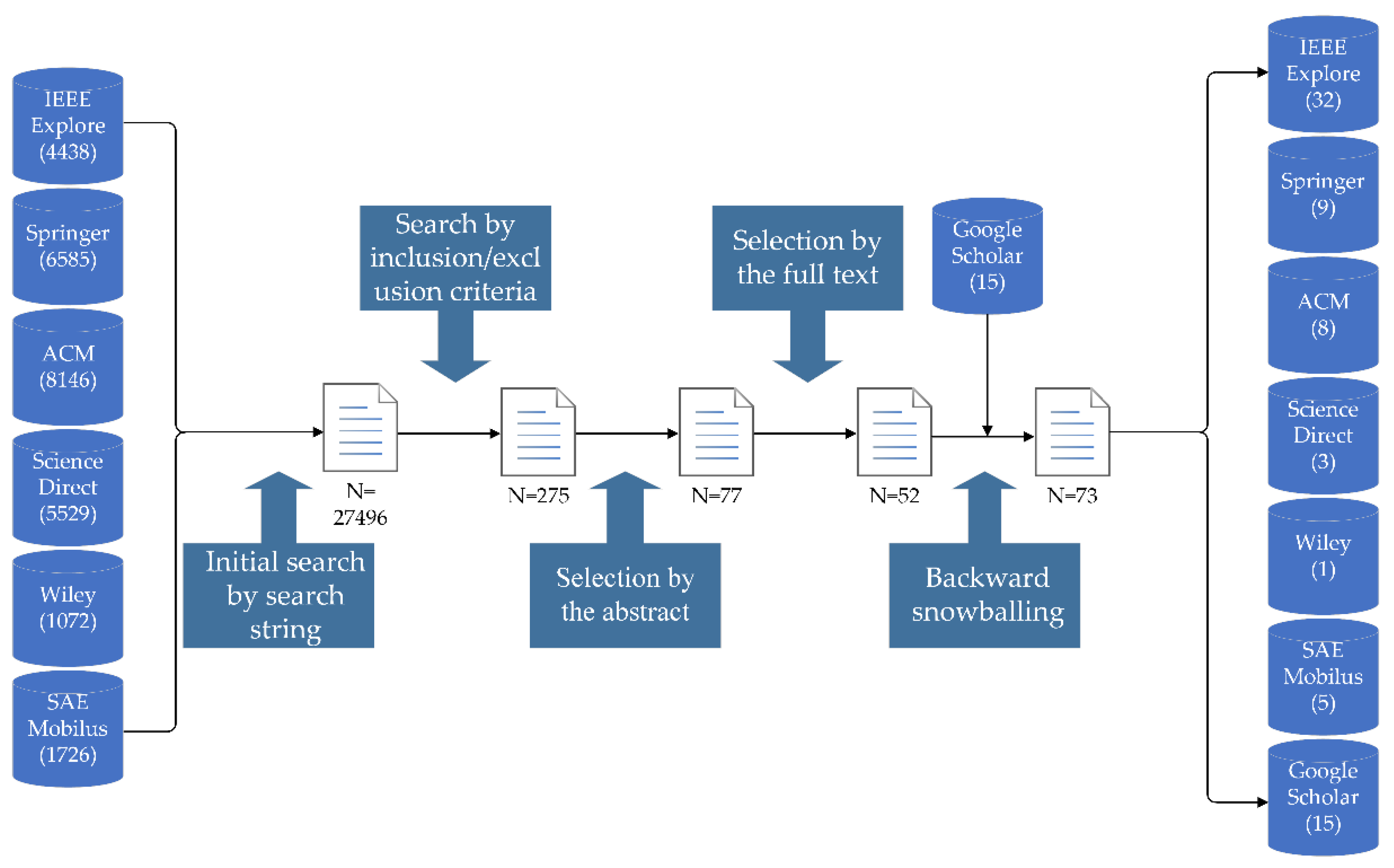
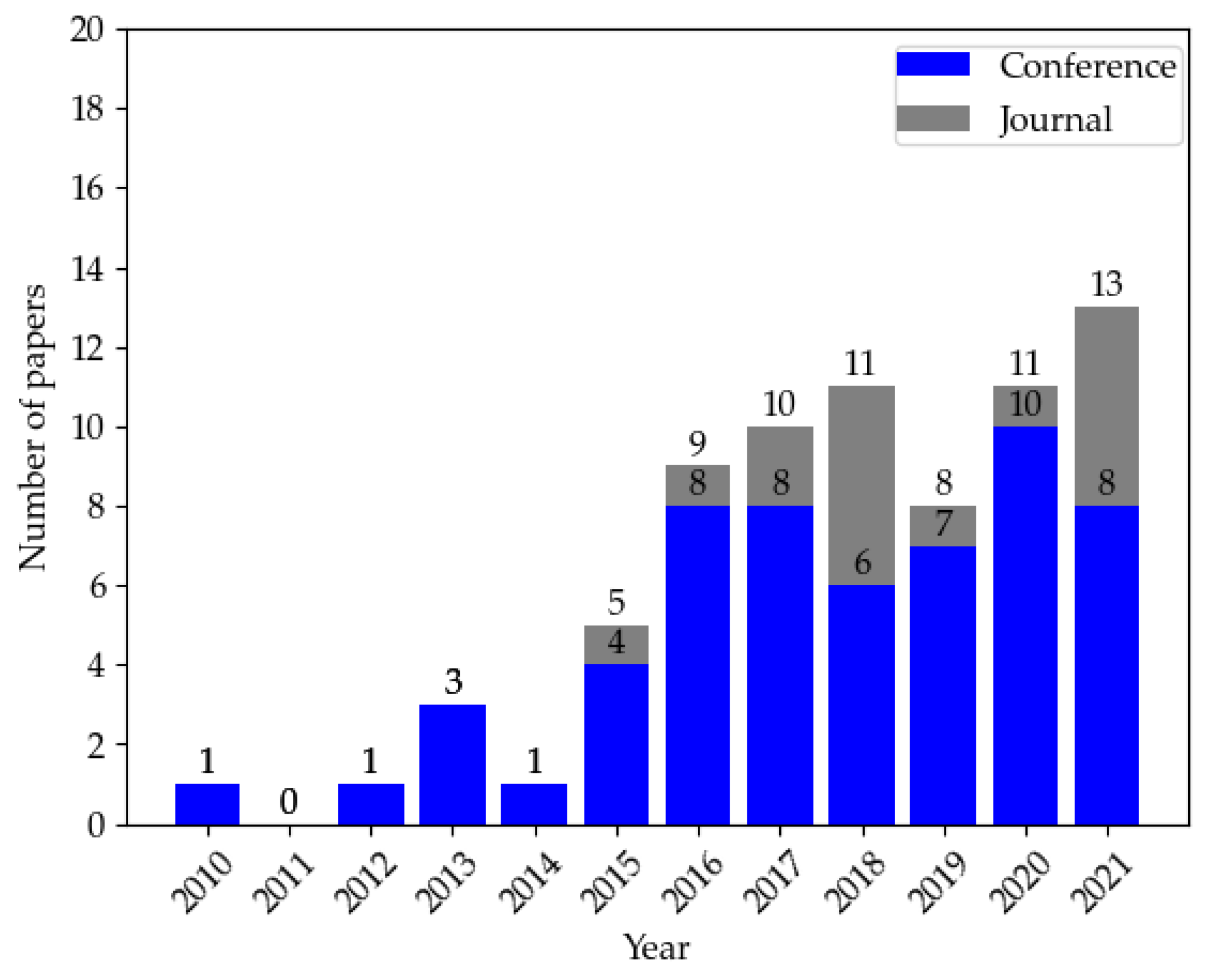
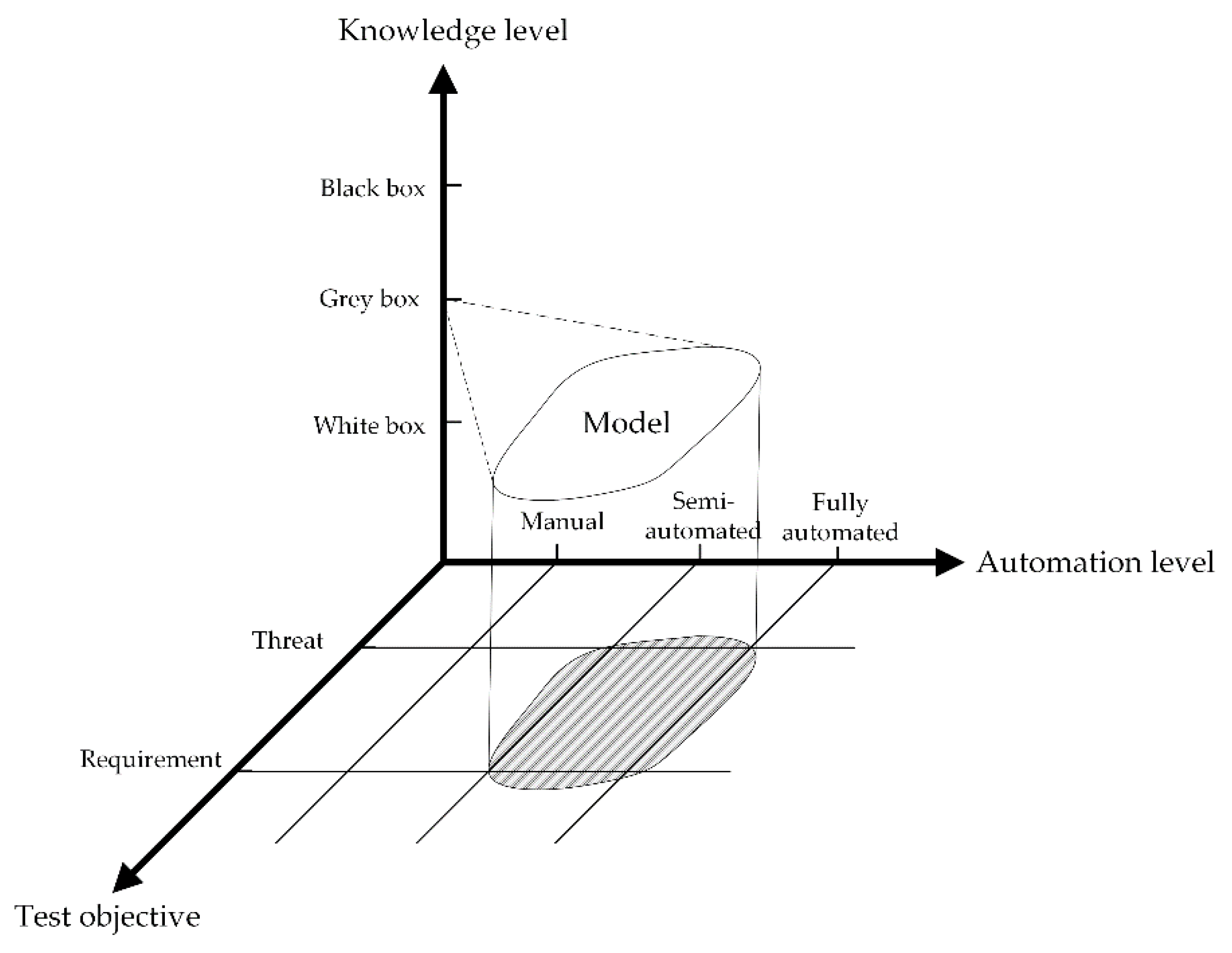
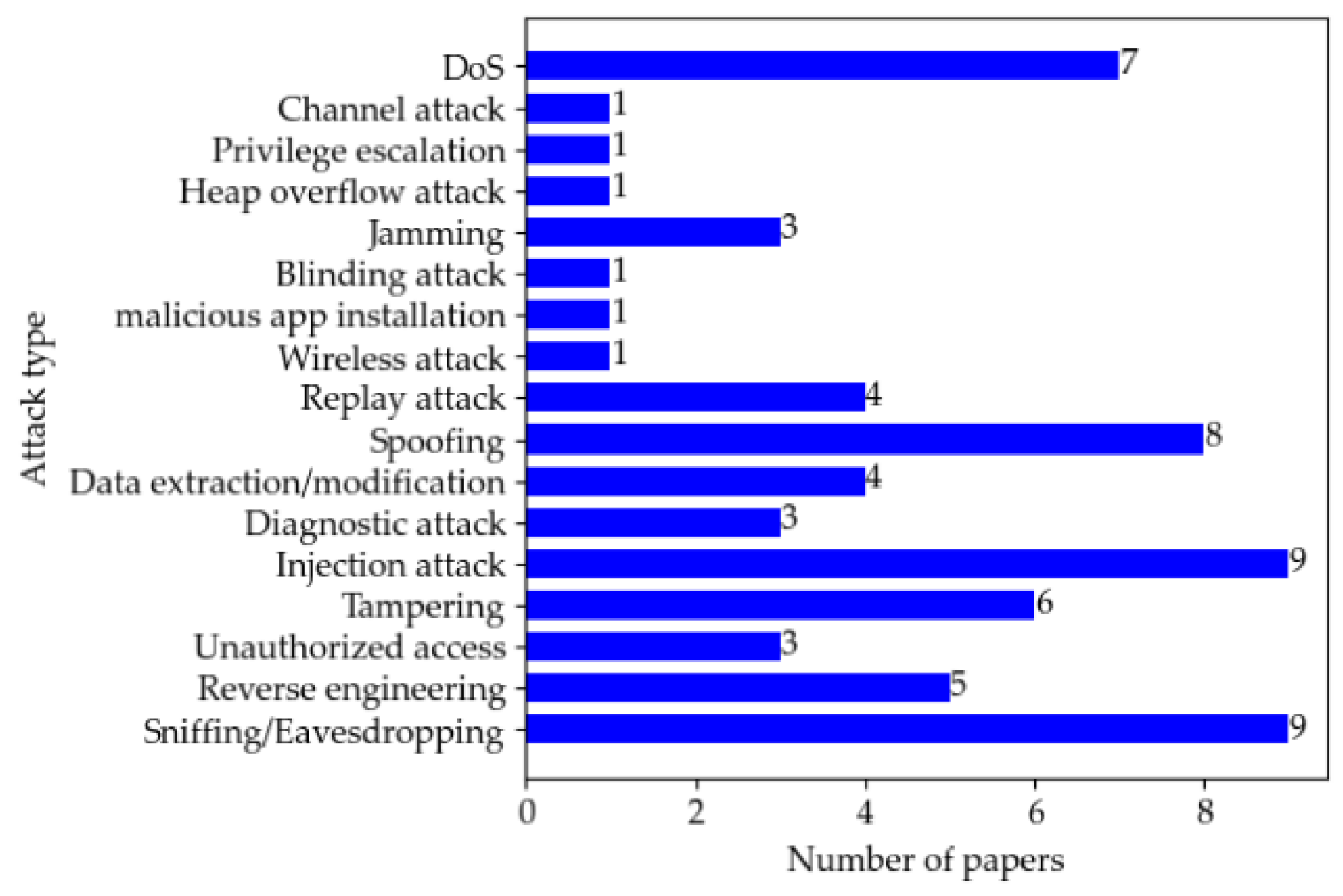
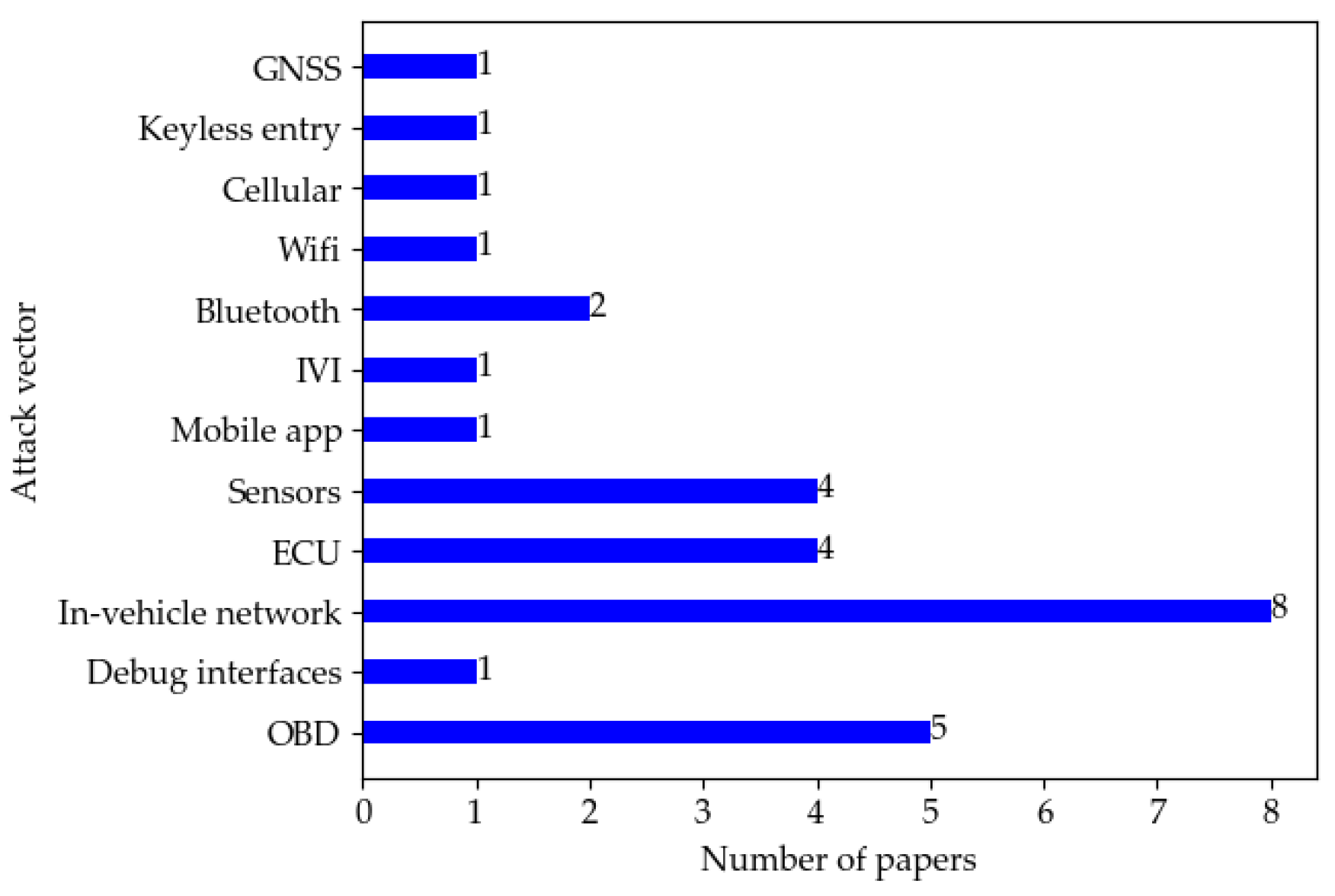
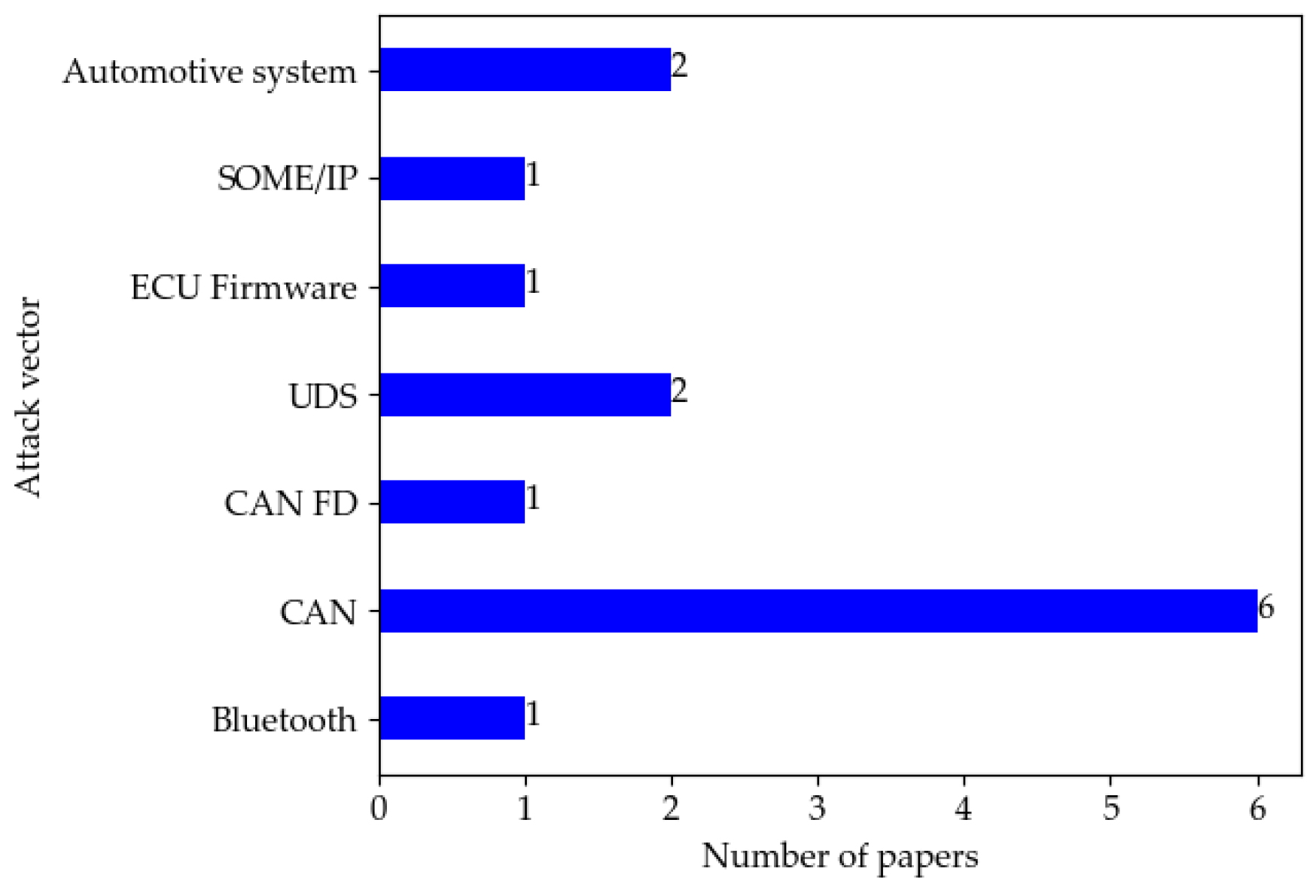

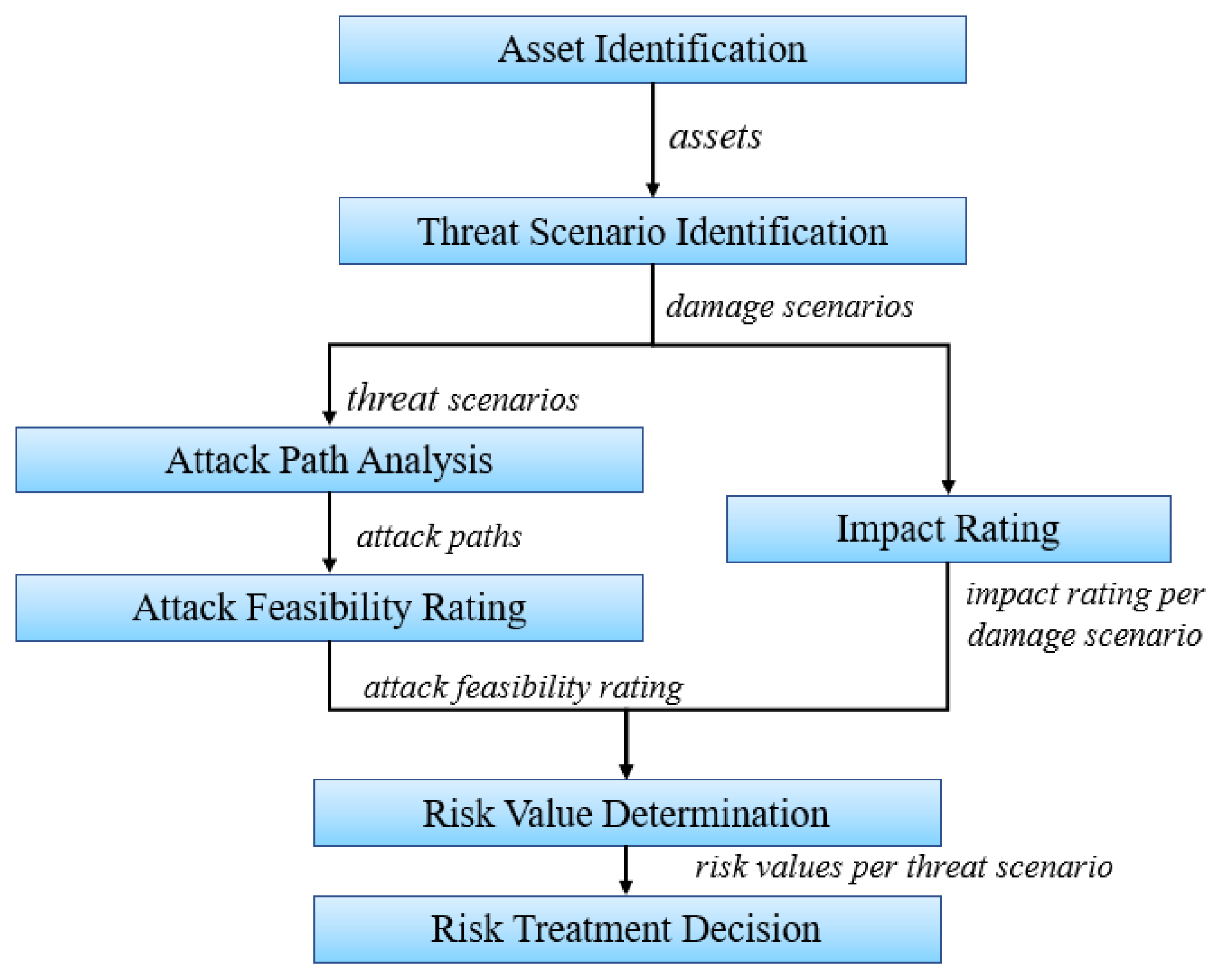


| Database | URL |
|---|---|
| IEEE Explore | https://ieeexplore.ieee.org/ |
| Springer | https://link.springer.com/ |
| ACM Digital Library | https://dl.acm.org/ |
| ScienceDirect | https://www.sciencedirect.com/ |
| Wiley | https://onlinelibrary.wiley.com/ |
| SAE Mobilus | https://saemobilus.sae.org/ |
| Google Scholar | https://scholar.google.com/ |
| Aspect | Inclusion Criteria | Exclusion Criteria |
|---|---|---|
| Time | 2010–2021 | Not within the defined time |
| Language | Papers written in English | Papers not written in English |
| Accessibility | Full text is available | Full text is not available |
| Topic | Topics about security testing in the automotive domain | Papers related to general automotive security topics, including security mechanisms, design, etc. |
| Is it peer reviewed? | Yes | No |
| Database | Initial Search | Inclusion/ Exclusion Criteria | Abstract | Full Text | Backward Snowballing |
|---|---|---|---|---|---|
| IEEE Explore | 4438 | 81 | 42 | 30 | 32 |
| Springer | 6585 | 40 | 13 | 8 | 9 |
| ACM Digital Library | 8146 | 69 | 10 | 6 | 8 |
| ScienceDirect | 5529 | 52 | 3 | 2 | 3 |
| Wiley | 1072 | 16 | 1 | 1 | 1 |
| SAE Mobilus | 1726 | 17 | 8 | 5 | 5 |
| Google Scholar | N/A | N/A | N/A | N/A | 15 |
| Total | 27,496 | 275 | 77 | 52 | 73 |
| Aspect | Black-Box Testing | Grey-Box Testing | White-Box Testing |
|---|---|---|---|
| Time | Short | Medium | Long |
| Cost | Low | Medium | High |
| Test coverage | Low | Medium | High |
| Knowledge of the target | Little | Medium | Much |
| Aspect | Fully Automated Testing | Semi-Automated Testing | Manual Testing |
|---|---|---|---|
| Time | Short | Medium | Long |
| Cost | Low | Medium | High |
| Efficiency | High | Medium | Low |
| Knowledge of the target | Little | Medium | Much |
| Aspect | Static/Dynamic Code Analysis | Communication Service Scanning | |
|---|---|---|---|
| Wired | Wireless | ||
| Time | Long | Medium | Low |
| Cost | High | Medium | Low |
| Test scope | Application source code | Wired communication (In-vehicle network) | Wireless communication (Bluetooth, Wi-Fi, cellular) |
| Limitation | Source code required | Physical contact required | Physical contact not required |
| Literature | Year | Attack Vector | Attack Type | Knowledge Level |
|---|---|---|---|---|
| Koscher [26] | 2010 | OBD, CAN, ECU | Sniffing, DoS, reverse engineering, unauthorized access, ECU tampering, injection attack | ■ |
| Miller [30] | 2013 | OBD, CAN, ECU | Sniffing, DoS, injection attack, diagnostic attack, firmware extraction/modification, ECU tampering, detecting attacks | ■ |
| Shoukry [31] | 2013 | ABS wheel speed sensors | Spoofing, tampering, injection attack | ■ |
| Woo [32] | 2015 | OBD, CAN, Mobile app, Bluetooth | Sniffing, DoS, replay attack, wireless attack, malicious app installation | ■ |
| Petit [33] | 2015 | Sensors | Blinding attack, jamming attack, replay attack relay attack, spoofing | ■ |
| Abbott-McCune [34] | 2016 | OBD, CAN | Sniffing, DoS, replay attack | ■ |
| Mazloom [27] | 2016 | IVI | Data extraction, reverse engineering, heap overflow attack, malicious code injection | ■ |
| Yan [28] | 2016 | Sensors | Jamming attack, spoofing | ■ |
| Nie [35] | 2017 | Wi-Fi, cellular, CAN | Privilege escalation, Unauthorized access, ECU tampering, reverse engineering, injection attack | ■ |
| Cheah [36] | 2017 | Bluetooth | Sniffing, DoS, data extraction, injection attack | ■ |
| Shin [29] | 2017 | Lidar | Channel attack | ■ |
| Milburn [37] | 2018 | CAN debug interfaces, ECU | Firmware extraction/modification, fault injection | ■ |
| Jeong [38] | 2018 | Keyless entry | Relay attack | ■ |
| Dürrwang [39] | 2018 | Airbag ECU | Diagnostic attack, signal tampering | ■ |
| Sommer [40] | 2019 | In-vehicle network | Eavesdropping, reverse engineering | ■ |
| He [41] | 2020 | GNSS | Spoofing, jamming attack | ■ |
| Zachos [42] | 2020 | OBD, CAN | Spoofing, diagnostic attack | ■ |
| He [43] | 2020 | OTA | Sniffing, DoS, spoofing, tampering, replay attack, unauthorized access, reverse engineering | ■ |
| Wen [44] | 2020 | Wireless OBD dongle | Spoofing, eavesdropping, injection attack | ■ |
| Ebert [16] | 2021 | Ethernet, IVI | DoS, spoofing, eavesdropping, malicious code injection | 🞕 |
| Literature | Attack Vector | Characteristics | Knowledge Level | Type | Testing Platform |
|---|---|---|---|---|---|
| Lee [45] | Bluetooth, CAN | Attacking ECU | ■ | Mutation | Instruments, real ECU |
| Fowler [46] | CAN | Reversing engineer, attacking network | ■ | Mutation | Vehicle simulator, an instrument cluster |
| Fowler [47] | CAN | Reversing engineer, inject message into ECU | ■ | Mutation | Display ECU |
| Werquin [48] | CAN | Reverse engineering | ■ | Mutation | Instrument Clusters |
| Radu [49] | CAN, ECU Firmware | Control flow graph, static analysis | ☐ | Generation | Real ECU |
| Zhang [50] | CAN | Bit flip rate, generative adversarial network | ■ | Hybrid | Actual vehicle, IDS |
| Nishimura [51] | CAN FD | Adaption for CAN FD, test execution time measurement | ■ | Mutation | Real ECU |
| Li [52] | SOME/IP | Attach fuzzing mode, structural mutation | 🞕 | Hybrid | Program from GENIVI/vsomeip |
| Bayer [53] | UDS | UDS fuzzing | ☐ | Generation | Simulated ECU |
| Patki [54] | UDS | UDS fuzzing | ☐ | Generation | Real ECU |
| Moukahal [55] | Automotive system | Vulnerability-oriented fuzz, structure-aware mutation | 🞕 | Hybrid | OpenPilot |
| Moukahal [56] | Automotive system | Prioritized and targeted concolic execution | 🞕 | Hybrid | OpenPilot |
| Method | Brief Description | Application Scope | Threat Model | Co-Analysis |
|---|---|---|---|---|
| EVITA [59] | A method in the E-safety Vehicle Intrusion Protected Applications (EVITA) project which provides four evaluation dimensions: safety, privacy, financial, and operational. | Vehicular IT systems | Attack tree | Yes |
| HEAVENS [60] | A method in the HEAling vulnerabilities to enhance software (HEAVENS) project, which provides a complete evaluation process to propose a systematic approach so that cybersecurity requirements for automotive electrical and electronic systems can be obtained | Automotive Electrical and electronic systems | STRIDE | Yes |
| FMVEA [61] | FMVEA (Failure Mode, Vulnerabilities and Effects Analysis) extends the FMEA approach with security threat models | Automotive cyber-physical systems | STRIDE | Yes |
| SAHARA [62] | SAHARA (security-aware hazard analysis and risk assessment) is a method that combines HARA in functional safety and STRIDE threat models | Automotive embedded systems | STRIDE | Yes |
| SARA [63] | SARA is a systematic TARA framework that includes improved threat models, asset maps, new attack methods, attacker participation in the attack tree, and new driving system metrics | Automated driving system | STRIDELC, Attack tree, Attack map | Yes |
| CHASSIS [64] | CHASSIS (Combined harm assessment of safety and security) is a safety and security co-analysis method for information systems based on HAZOP guidewords | Automotive cyber-physical systems | HAZOP | Yes |
| TVRA [65] | TVRA (Threat, Vulnerabilities, and implementation Risks Analysis) is a process-driven threat analysis and risk assessment method proposed by the European Telecommunications Standards Institute (ETSI) | Automotive data/telecommunications networks | Threat tree | No |
| SINA [66] | SINA (Security in Networked Automotive) is a method to identify security issues for Connected automotive systems | Connected automotive systems | STRIDE, Attack tree | Yes |
| SGM [67] | SGM (Security Guideword Method) is a safety analysis method using security guide words | Automotive embedded systems | SGM, Attack Tree | Yes |
| Author | Model Type | Model Characteristics | Use Case | Solution or Concept |
|---|---|---|---|---|
| Aouadi [76] | EFSM | An automatic formal testing tool for distributed systems is proposed, which permits the automatic generation of test cases | ITS | Solution |
| Dos Santos [74] | PrT net | Create threat and attack model with PrT net at an abstract level | Vehicular systems and networks. | Concept |
| Dos Santos [79] | Attack tree, CSP | Use CSP to create automotive bus systems and corresponding attack models | Vehicular systems | Concept |
| Cheah [80] | Attack tree, CSP | The attack tree can be transferred into a formal structure with CSP, and test cases can be generated automatically | Bluetooth-enabled OBD device | Concept |
| Cheah [71] | Attack tree | Develop a proof-of-concept tool to execute testing on vehicle compromise based on the attack model | Bluetooth, diagnostics device | Concept |
| Heneghan [72] | CSP | Security evaluation of ECU with CSP formal models | ECUs | Concept |
| Mahmood [73] | Attack tree, CSP | Construct threat model with attack trees and generate test cases by model-checking | OTA | Solution |
| Sommer [75] | EFSM | Security model with attack privileges and vulnerabilities | Vehicle networks | Concept |
| Marksteiner [77] | Cyber digital twin model | A cyber digital twin model using binary analysis and generating test cases through formal transformation, model checking, and fault injection | Vehicular systems | Concept |
| Marksteiner [78] | Attack tree | Construct attack tree model with fingerprinting and model learning | Vehicular systems | Concept |
| Testbeds | Network Protocol | Type | Cost | Functionality and Features |
|---|---|---|---|---|
| A cyber assurance testbed for heavy vehicle electronic controls [81] | J1939, J1708, CAN | H | Low | Supports remote experimentation, Key exchange strength and IDS assessment |
| A testbed for security analysis of modern vehicle systems [82] | CAN, Ethernet | H | Low | A testbed integrating CAN simulator and IVI system with flexible configuration for efficient security analysis |
| A testbed for automotive cybersecurity [83] | CAN | S | Low | A testbed consisting of a real-time CAN simulator and supporting reverse-engineering |
| ATG: An Attack Traffic Generation Tool for Security Testing of In-vehicle CAN Bus [84] | CAN | S | Low | Automatic generation of CAN attack traffic |
| PASTA: Portable Automotive Security Testbed with Adaptability [85] | CAN | H | Low | An open, safe, adaptable, and portable testbed against automotive attacks |
| A hardware-in-loop based testbed for automotive embedded systems cybersecurity evaluation [86] | V2X, CAN | H | Low | A hardware-in-the-loop testbed that can simulate V2X communication and perform GPS spoofing |
| A Connected Vehicle System (CVS) prototype testbed [87] | ETSI ITS-G5, 3G/4G, LTE, Ethernet, CAN, Wi-Fi | H | Medium | Support V2I communication test and security assurance evaluation |
| Ori: A Greybox Fuzzer for SOME/IP Protocols in Automotive Ethernet [52] | Ethernet, SOME/IP | S | Low | Fuzz SOME/IP protocols to find vulnerabilities |
| A novel testbed for automotive security analysis [88] | CAN | H | Medium | Data collected are analyzed visually and replayed through a test environment similar to a vehicle |
| SEPAD: Security Evaluation Platform for Autonomous Driving [89] | CAN/CAN FD, PLC, Bluetooth, WLAN, cellular, Ethernet | H | Medium | A novel testbed for autonomous driving, supporting security mechanisms testing |
| HybridgeCAN: a hybrid bridged CAN platform for automotive security testing [90] | CAN | H | Low | A low-cost testbed connecting physical ECUs with virtual components |
Publisher’s Note: MDPI stays neutral with regard to jurisdictional claims in published maps and institutional affiliations. |
© 2022 by the authors. Licensee MDPI, Basel, Switzerland. This article is an open access article distributed under the terms and conditions of the Creative Commons Attribution (CC BY) license (https://creativecommons.org/licenses/by/4.0/).
Share and Cite
Luo, F.; Zhang, X.; Yang, Z.; Jiang, Y.; Wang, J.; Wu, M.; Feng, W. Cybersecurity Testing for Automotive Domain: A Survey. Sensors 2022, 22, 9211. https://doi.org/10.3390/s22239211
Luo F, Zhang X, Yang Z, Jiang Y, Wang J, Wu M, Feng W. Cybersecurity Testing for Automotive Domain: A Survey. Sensors. 2022; 22(23):9211. https://doi.org/10.3390/s22239211
Chicago/Turabian StyleLuo, Feng, Xuan Zhang, Zhenyu Yang, Yifan Jiang, Jiajia Wang, Mingzhi Wu, and Wanqiang Feng. 2022. "Cybersecurity Testing for Automotive Domain: A Survey" Sensors 22, no. 23: 9211. https://doi.org/10.3390/s22239211
APA StyleLuo, F., Zhang, X., Yang, Z., Jiang, Y., Wang, J., Wu, M., & Feng, W. (2022). Cybersecurity Testing for Automotive Domain: A Survey. Sensors, 22(23), 9211. https://doi.org/10.3390/s22239211








